 Cardinal Surveys
Company
Cardinal Surveys
Company Cardinal Surveys
Company
Cardinal Surveys
Company
Step Rate Testing
When you don't want to make headlines:

“A reliable estimate of the formation parting or fracture extension pressure is important for efficient operation of water floods and tertiary recovery projects.”
"Rapid water breakthrough in production wells as a direct result of exceeding a certain critical injection pressure in nearby injection wells was observed as early as 1945. This critical injection pressure is called the formation or fracture parting pressure (FPP). The FPP is equivalent to the ‘fracture extension/propagation pressure’ in the hydraulic fracturing literature. Several studies recently demonstrated that a fracture will propagate if injection is above the FPP and the injection/withdrawal ratio is greater than one. In addition to this uncontrolled fracture extension, injection above the FPP may also cause fracturing out of pay. These factors may lead to premature breakthrough of injected fluids, poor sweep efficiency, reduced recovery, and loss of costly injection fluids. “
“On the other hand, injection far below the FPP may result in injection volumes much lower than the allowable maximum and a reduced rate of oil recover. A reliable estimate of the FPP is therefore critical in conducting secondary and tertiary recovery projects.
- Pramod Singh, SPE, and Ram G. Agarwal, SPE, Amoco Production Co. SPE 18141, 1990.
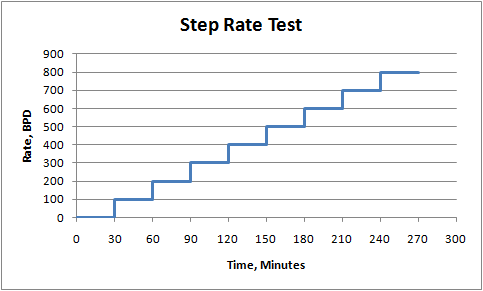
And pressure is measured (normally with a down-hole pressure tool):
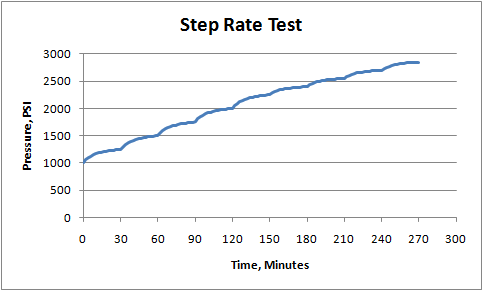 at is a “Step Rate Test (SRT)?”
at is a “Step Rate Test (SRT)?”Injection rate and pressure are then plotted. The FPP occurs where the pre and post fracture pressures intersect:
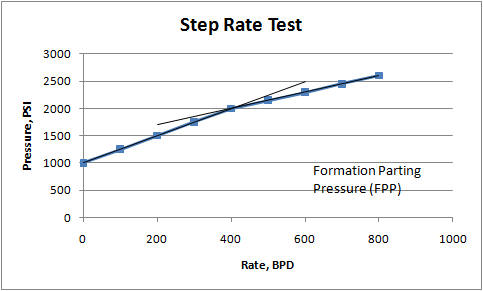
The New Mexico Oil Conservation Division (OCD), the Texas Rail Road Commission (RRC), and the U.S. Environmental Protection Agency (EPA) all require step rate tests to permit injection wells. In lue of a SRT, New Mexico and Texas allow injection below the following fracture gradients:
New Mexico: 0.2 PSI/FT
Texas: 0.5 PSI/FT
Actual Step Rate Test Gradients (Note in most cases that the actual exceeds the state maximums):
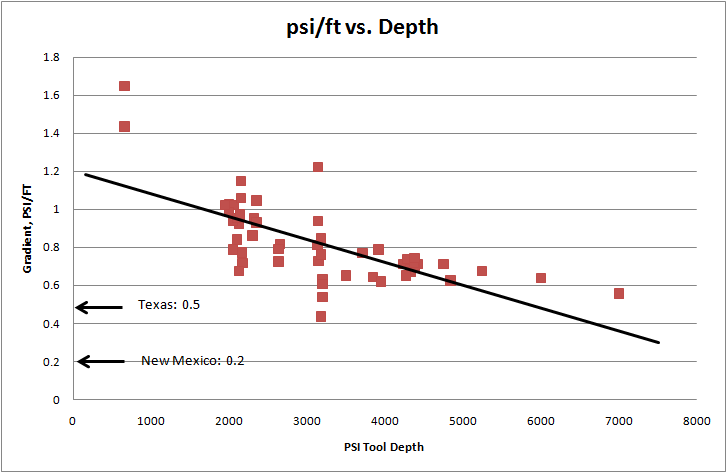
The following example show several wells in the same field. Note that each individual well has a unique FFP:
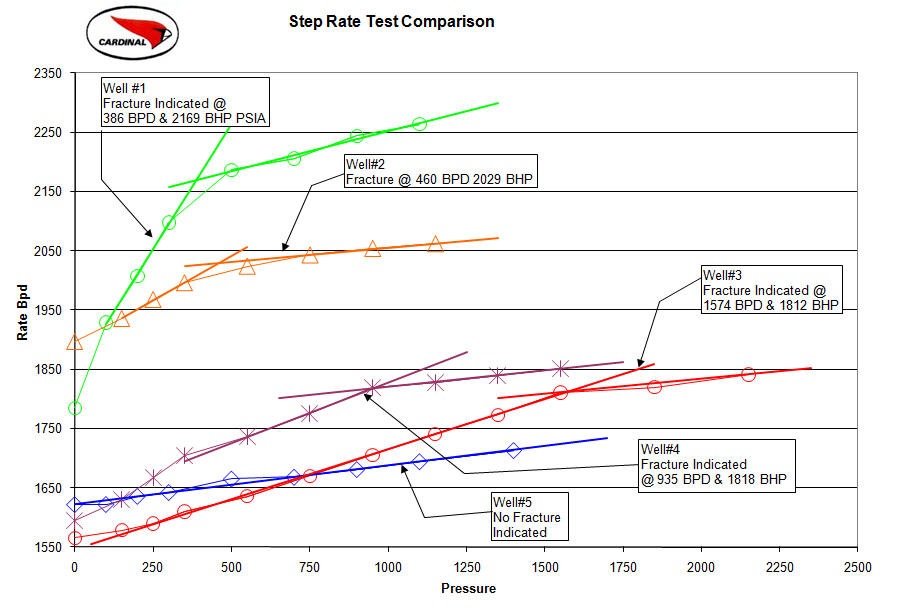
Step Rate Test Field Data Example:
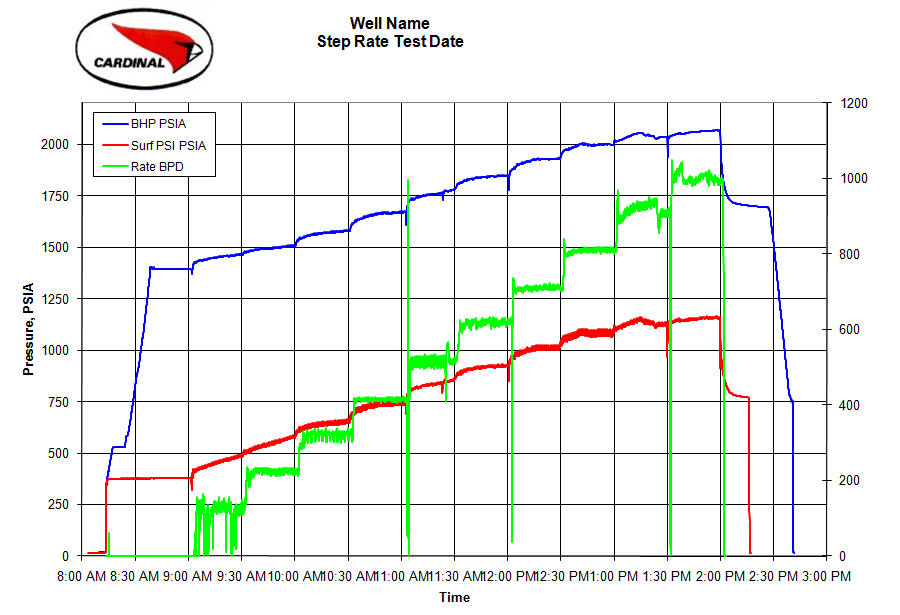
Step Rate Test Example Result:
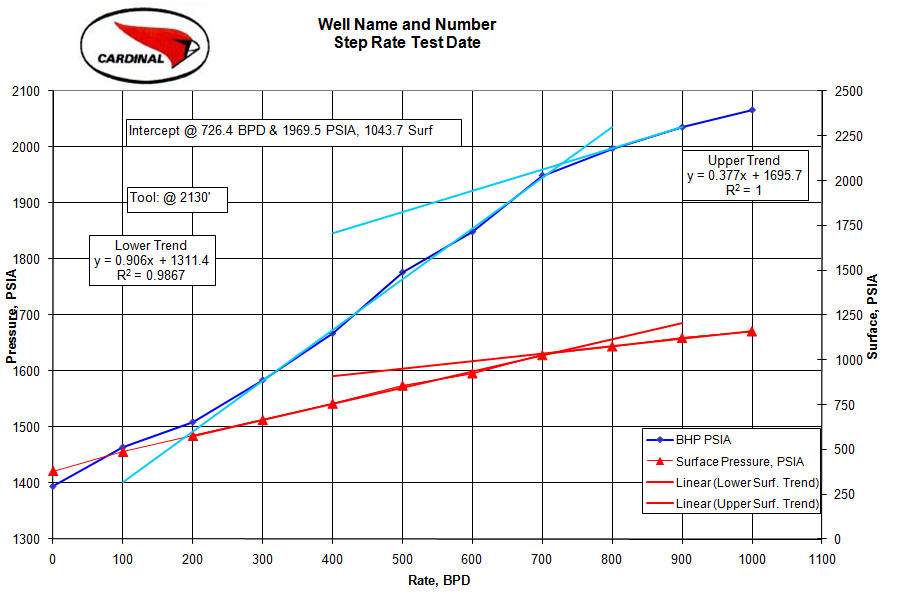
Step Rate Test Procedure and Documents:
Step Rate Test (SRT) Procedure (from State of Texas Rail Road Commission):
Goal: Must demonstrate that formation fracturing will not occur at the proposed injection pressure.
Method: A Step Rate Test (SRT) must be used to demonstrate.
Requirements: Must measure both surface and bottom hole pressure (BHP).
The test well should be shut in long enough so that the bottom-hole pressure is near the shut-in formation pressure (No less than 48 hours.).
The well may need to be backflowed if the shut-in pressure is above the expected fracture pressure of 0.5 psi/ft. of depth.
Suggested rates for the test are 5, 10, 20, 40, 60, 80, and 100% of the proposed maximum daily injection volume and corresponding pressures.
The first rate should be the formation matrix rate (the rate at which the formation begins to accept fluid).
At least two rates must be below the expected fracture pressure of 0.5 psi/ft. of depth.
Each rate must be allowed to stabilize before proceeding to the next higher rate. (60 min for formation permeability < 10 millidarcies, and 30 min for formation permeability > 10 millidarcies.)
EACH STEP SHOULD LAST EXACTLY AS LONG AS THE PRECEDING STEP, ie, all steps should be of the same duration.
Once the fracture pressure is reached, continuing the test by stepping downward will refine the fracture pressure and provide quality control for the test.
Step Rate Test Equipment and Presentation Requirements:
(1) Pump truck or transport with a pump which is capable of delivering the full range of injection rates anticipated for the test. For example, 100 BPD to 2500 BPD. Further, the pump must be able to pump smoothly and reliably. Note that a 10 step test may last for several hours.
(2) Sufficient water source. Make sure that there is enough water available for the total test. Several hundred barrels may be required. It may be necessary to set a temporary test or frac tank(s) and fill it prior to the test.
(3) Flow measurement and recording. A flow meter or set of meters must be available to measure and record all the rates anticipated. For example, one meter may range from 50 – 500 BPD, and the second meter range from 500 – 5000 BPD. Most individual turbine meters are not able to measure the entire range of a step rate test, so it usually requires two or more meters and the ability to readily switch between the meters.
(4) Sample interval. Data should be acquired at least every 5 – 10 seconds. A moving average should be applied to smooth out data irregularities.
(5) Pressure measurement and recording. Surface and down-hole pressures should both be acquired. While surface pressure alone, corrected for static pressure and friction losses, can theoretically be used, practical experience shows that bottom-hole pressure is normally required to accurately determine the FFP (Formation Parting Pressure.) The corresponding surface pressure can then be used to stay below the FFP.
(6) Presentation. All data, including the surface pressure, down-hole pressure, and injection rate should be recorded and presented in an actual data versus time formatted graph. The resulting step rate pressure chart showing rate and pressure with linear regression of down-hole pressure vs. rate showing the intersection (FFP) should also be shown.
(Note example charts show above.)
Downloadable SRT Procedure: Word Document Adobe Portable Document
Power Point Presentation on Step Rate Testing.
Return to Cardinal Surveys Welcome Page
